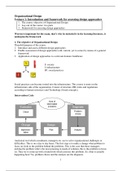Summary
Summary Synopsis Organizational Design (all lecture slides incl. Notes)
- Course
- Institution
All lectures slides including notes of the course Organizational Design of the Master Organizational Design and Developmand . Notes are in italics.
[Show more]



